PONTIAC GRAND PRIX 1998 Owners Manual
Manufacturer: PONTIAC, Model Year: 1998, Model line: GRAND PRIX, Model: PONTIAC GRAND PRIX 1998Pages: 402, PDF Size: 17.96 MB
Page 311 of 402
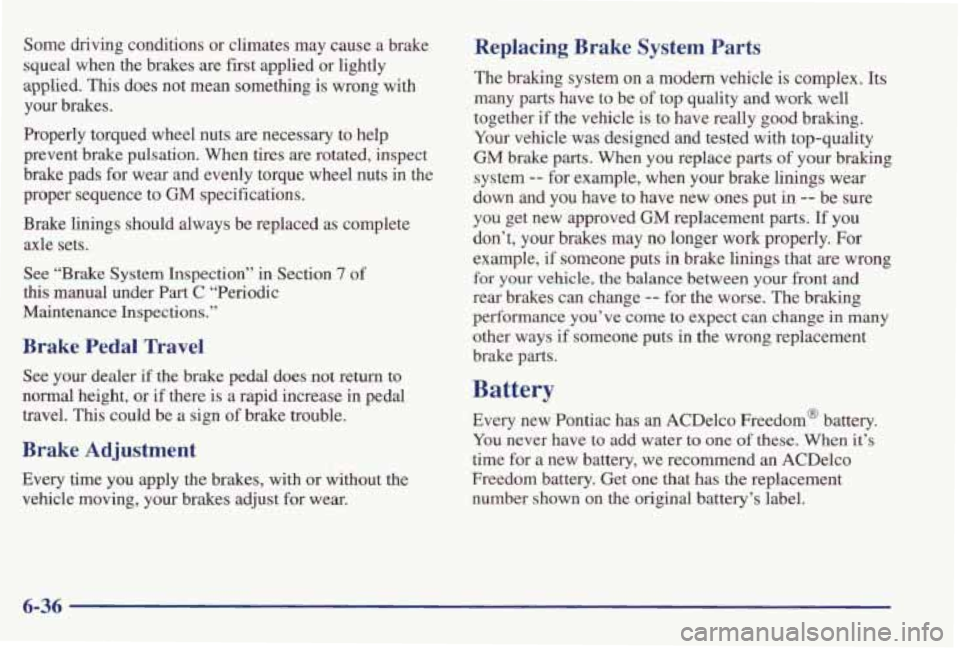
Some driving conditions or climates may cause a brake
squeal when the brakes are first applied or lightly
applied.
This does not mean something is wrong with
your brakes.
Properly torqued wheel nuts are necessary to help
prevent brake pulsation. When tires are rotated, inspect
brake pads for wear and evenly torque wheel nuts in the
proper sequence to GM specifications.
Brake linings should always be replaced as complete
axle sets.
See “Brake System Inspection” in Section
7 of
this manual under Part C “Periodic
Maintenance Inspections.”
Brake Pedal Travel
See your dealer if the brake pedal does not return to
normal height, or
if there is a rapid increase in pedal
travel.
This could be a sign of brake trouble.
Brake Adjustment
Every time you apply the brakes, with or without the
vehicle moving, your brakes adjust for wear.
Replacing Brake System Parts
The braking system on a modem vehicle is complex. Its
many parts have to
be of top quality and work well
together
if the vehicle is to have really good braking.
Your vehicle was designed and tested with top-quality
GM brake parts.
When you replace parts of your braking
system
-- for example, when your brake linings wear
down and you have to have new ones put in
-- be sure
you get new approved GM replacement parts. If you
don’t, your brakes
may no longer work properly. For
example, if someone puts in brake linings that are wrong
for your vehicle, the balance between your front and
rear brakes can change
-- for the worse. The braking
performance you’ve
come to expect can change in many
other ways if someone puts in the wrong replacement
brake parts.
Battery
Every new Pontiac has an ACDelco Freedom@ battery.
You never have to add water to one of these. When it’s
time for a
new battery, we recommend an ACDelco
Freedom battery. Get one that has the replacement
number shown on the original battery’s label.
6-36
Page 312 of 402

Vehicle Storage
If you’re not going to drive your vehicle for 25 days or
more, remove the black, negative (-) cable from the
battery. This will help keep your battery
from
running down.
/I CAUTION:
Batteries have acid that can burn you and gas
that can explode. You can be badly hurt
if you
aren’t careful. See “Jump Starting” in the Index
for tips on working around
a battery without
getting hurt.
Halogen Bulbs
Contact your dealer to learn how to prepare your vehicle
for longer storage periods.
Also, for your audio system, see “Theft-Deterrent
Feature” in the Index.
Bulb Replacement
In this section, you’ll find directions for changing the
bulbs on your vehicle. See “Replacement Bulbs” in the
Index to find the type
of bulb you should use. Halogen
bulbs have pressurized gas inside and
can burst
if you drop or scratch the bulb. You or
others could be injured. Be sure
to read and
follow the instructions on the bulb package.
Headlamps
1. Open the hood and support properly.
2. Remove the two bolts
from the top of the
headlamp assembly.
6-37
Page 313 of 402

3. Carefully remove the headlamp assembly from the
vehicle. Be careful
to avoid scratching or chipping
the paint on
the vehicle while removing.
4. Lift the plastic tab on the electrical connector and
pull the connector.
5. Turn the lamp socket ring a quarter of a turn
counterclockwise
to remove it from the
headlamp assembly.
Page 314 of 402
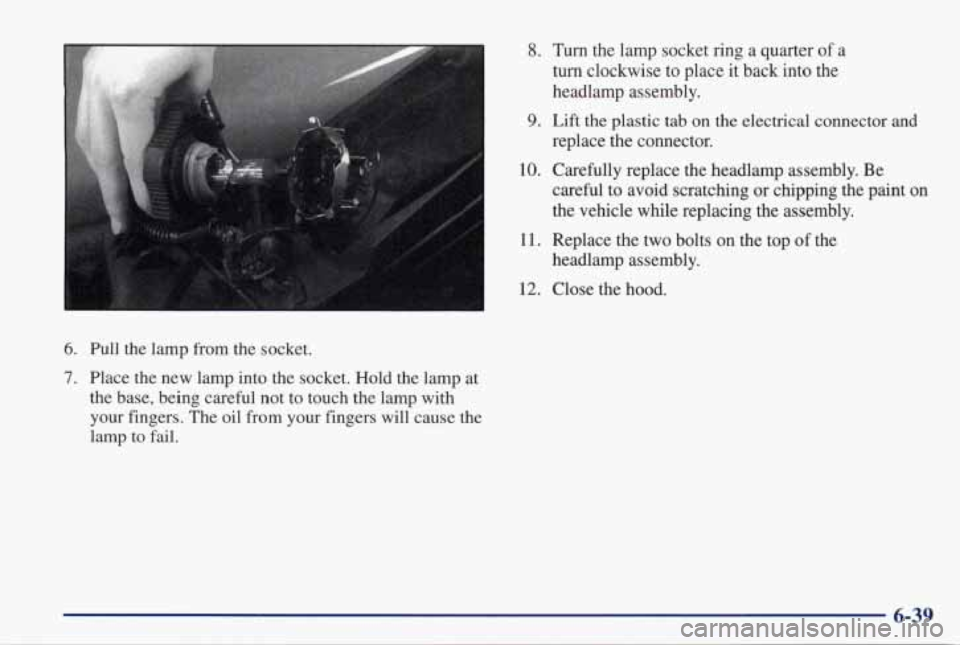
r
6. Pull the lamp from the socket.
7. Place the new lamp into the socket. Hold the lamp at
the base, being careful not to touch the lamp with your fingers. The oil from your fingers will cause the
lamp
to fail.
8. Turn the lamp socket ring a quarter of a
turn clockwise to place it back into the
headlamp assembly.
replace the connector.
9. Lift the plastic tab on the electrical connector and
10. Carefully replace the headlamp assembly. Be
careful to avoid scratching or chipping the paint on
the vehicle while replacing the assembly.
11. Replace the two bolts on the top of the
12. Close the hood.
headlamp assembly.
6-39
~~
Page 315 of 402
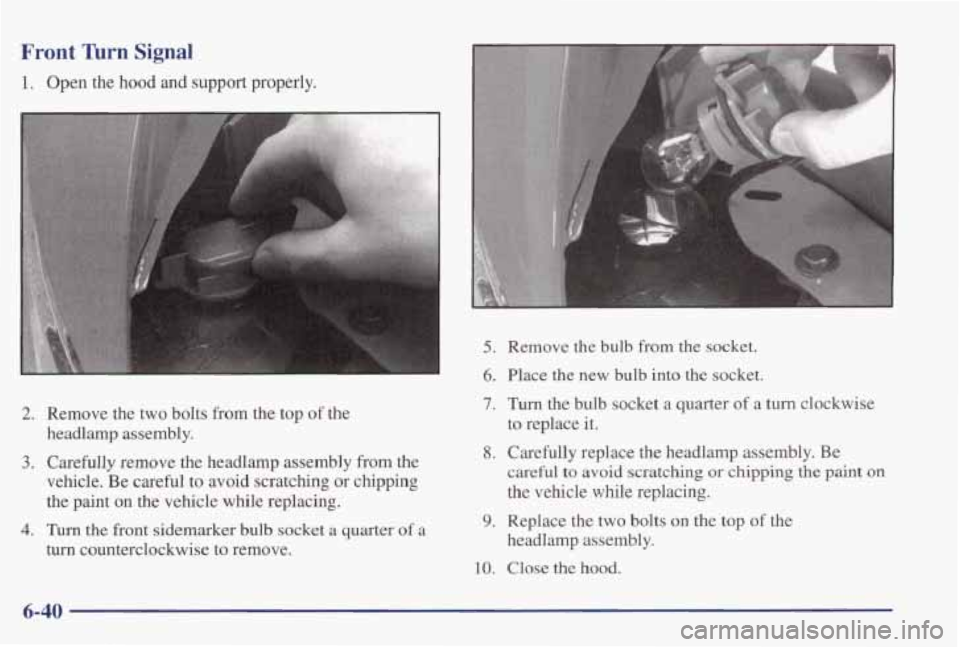
Front lhrn Signal
1. Open the hood and support properly.
2. Remove the two bolts from the top of the
headlamp assembly.
3. Carefully remove the headlamp assembly from the
vehicle. Be careful to avoid scratching or chipping
the paint on the vehicle while replacing.
turn counterclockwise to remove.
4. Turn the front sidemarker bulb socket a quarter of a
A
5. Remove the bulb from the socket.
6. Place the new bulb into the socket.
7. Turn the bulb socket a quarter of a turn clockwise
8. Carefully replace the headlamp assembly. Be
to replace it.
careful to avoid scratching or chipping the paint on
the vehicle while replacing.
9. Replace the two bolts on the top of the
headlamp assembly.
10. Close the hood.
6-40
Page 316 of 402
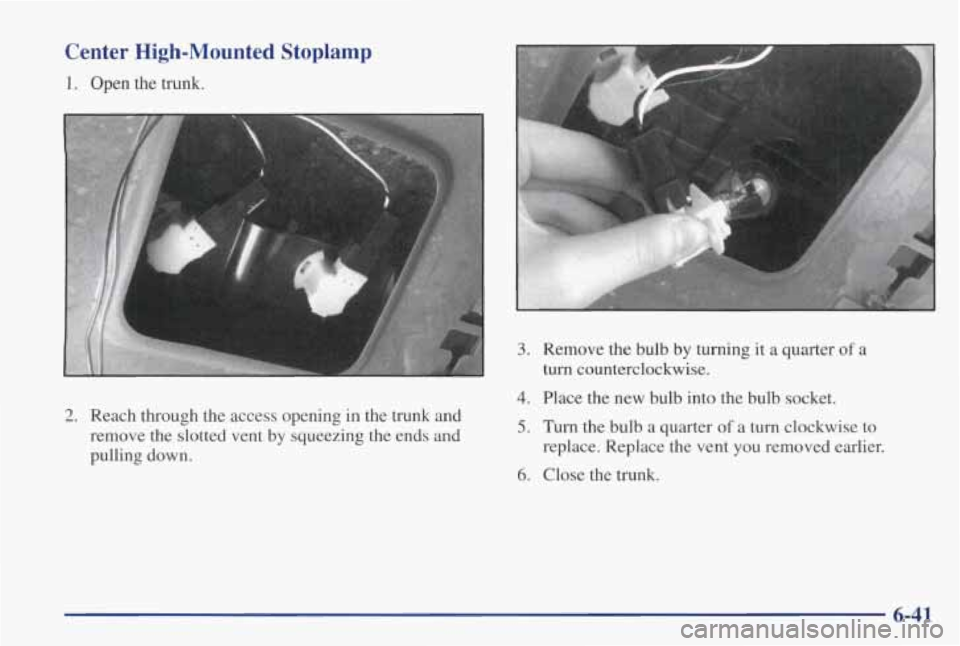
2. Reach through the access opening in the trunk and
remove the slotted vent by squeezing the ends and
pulling down.
3. Remove the bulb by turning it a quarter of a
4. Place the new bulb into the bulb socket.
5. Turn the bulb a quarter of a turn clockwise to
6. Close the trunk.
turn counterclockwise.
replace. Replace the vent you removed earlier.
6-41
Page 317 of 402
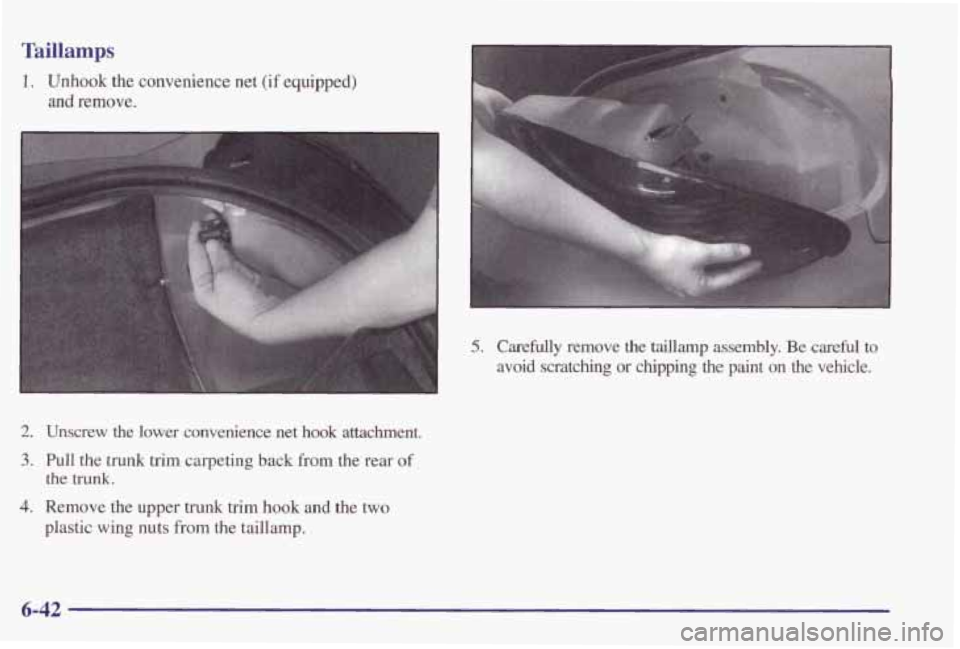
Taillamps
1. Unhook the convenience net (if equipped)
and remove.
2. Unscrew the lower convenience net hook attachment.
3. Pull the trunk trim carpeting back from the rear of
4. Remove the upper trunk trim hook and the two
the trunk.
plastic wing nuts from the taillamp.
5. Carefdly remove the taillamp assembly. Be carefid to
avoid scratching or chipping the paint on
the vehicle.
6-42
Page 318 of 402
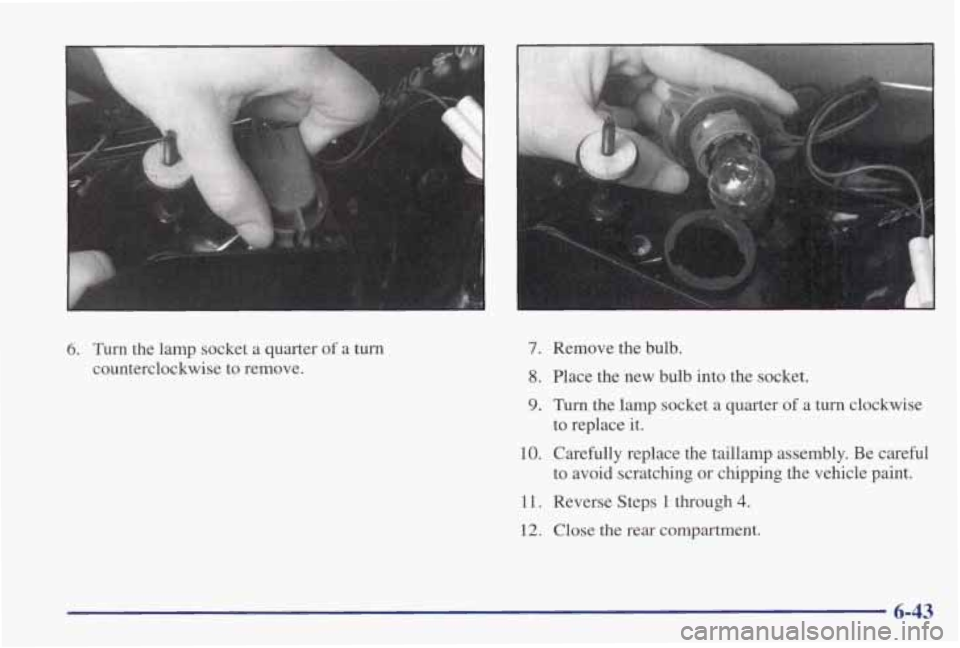
6. Turn the lamp socket a quarter of a turn
counterclockwise to remove.
7. Remove the bulb.
8. Place the new bulb into the socket.
9. Turn the lamp socket a quarter of a turn clockwise
10. Carefully replace the taillamp assembly. Be careful
11. Reverse Steps 1 through 4.
12. Close the rear compartment.
to replace
it.
to avoid scratching
or chipping the vehicle paint.
6-43
Page 319 of 402
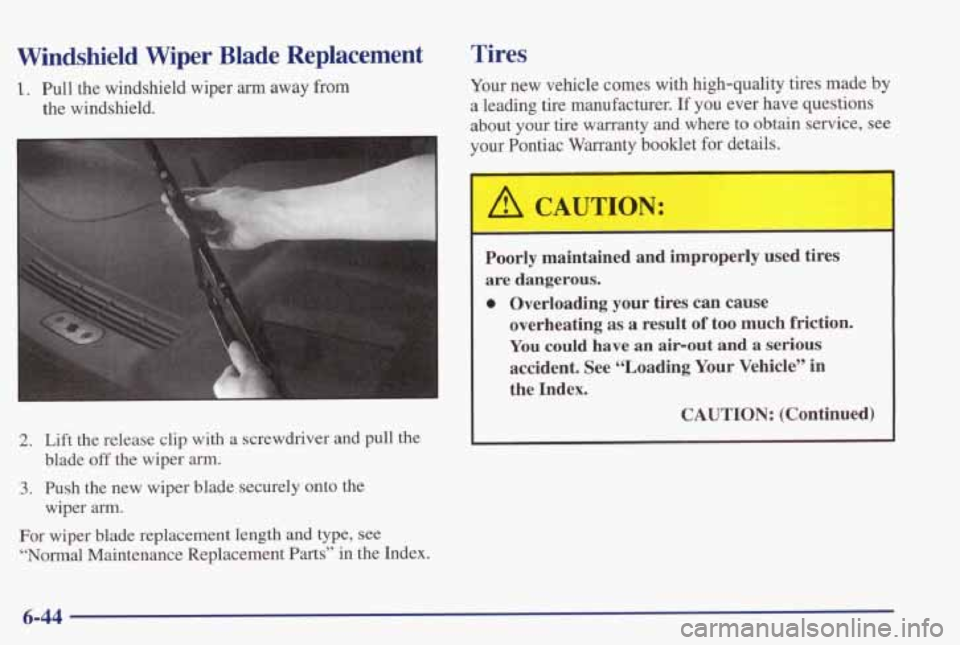
Windshield Wiper Blade Replacement
1. Pull the windshield wiper arm away from
the windshield.
2. Lift the release clip with a screwdriver and pull the
3. Push the new wiper blade securely onto the
For wiper blade replacement length and type, see
“Normal Maintenance Replacement Parts” in the Index.
blade
off the wiper arm.
wiper arm.
Tires
Your new vehicle comes with high-quality
tires made by
a leading tire manufacturer. If you ever have questions
about
your tire warranty and where to obtain service, see
your Pontiac
Warranty booklet for details.
1
‘
A CAUTION:
3
Poorly maintained and improperly used tires
are dangerous.
0 Overloading your tires can cause
overheating as a result of too much friction.
You could have an air-out and a serious
accident. See “Loading Your Vehicle” in
the Index.
CAUTION: (Continued)
6-44
Page 320 of 402
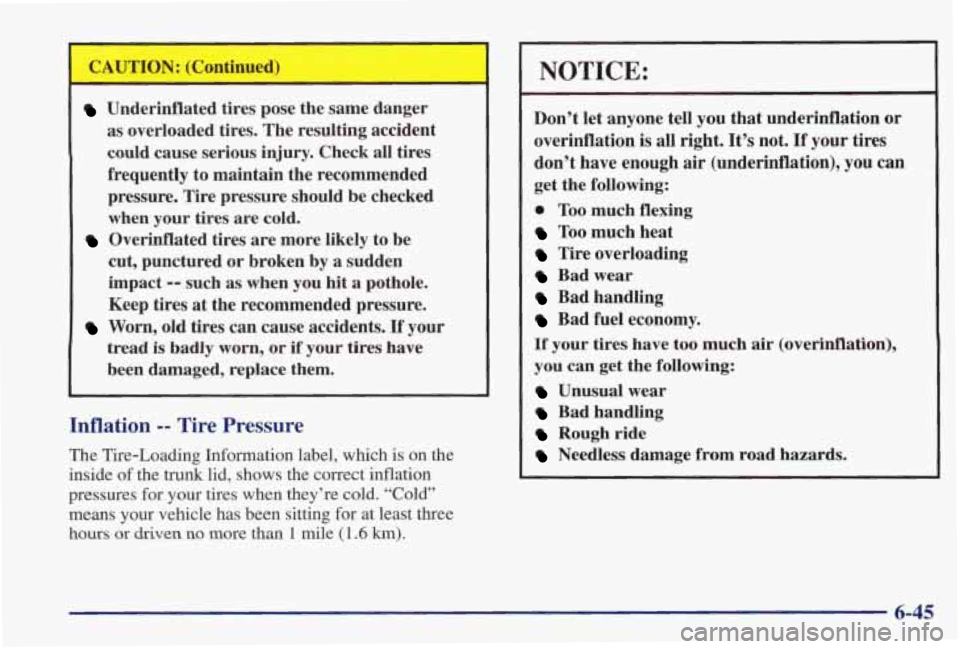
CAUTION: (Continued)
Underinflated tires pose the same danger
as overloaded tires. The resulting accident
could cause serious injury. Check all tires
frequently to maintain the recommended pressure. Tire pressure should be checked
when your tires are cold.
cut, punctured or broken by a sudden
impact
-- such as when you hit a pothole.
Keep
tires at the recommended pressure.
Worn, old tires can cause accidents. If your
tread
is badly worn, or if your tires have
been damaged, replace them.
Overinflated tires are more likely to be
Inflation -- Tire Pressure
The Tire-Loading Information label, which is on the
inside of the
trunk lid, shows the correct inflation
pressures for your tires when they’re cold. “Cold”
means your vehicle has been sitting for at least three
hours or driven no more than 1 mile (1.6 km).
NOTICE:
Don’t let anyone tell you that underinflation or
overinflation
is all right. It’s not. If your tires
don’t have enough air (underinflation), you can
get the following:
0 Too much flexing
Too much heat
Tire overloading
Bad wear
Bad handling
Bad fuel economy.
If your tires have too much air (overinfla
you can get the following:
Unusual wear
Bad handling
Rough ride
Needless damage from road hazards. .tion),
6-45